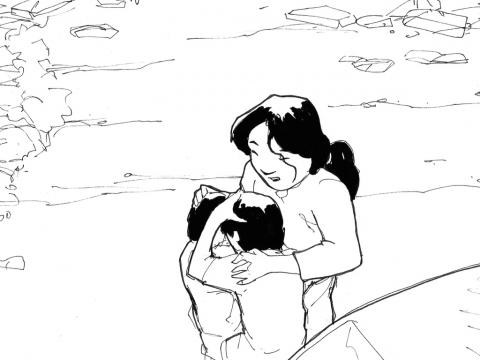The balancing act in a disaster

Illustration by James Dimanarig
25 April 2015. I remember that day vividly. I can recall the events of that day like it happened yesterday. I was home with my two boys, five and eleven. My boys were reading next to me in our living room after a hearty lunch. Suddenly there was an unusual noise. At first I thought it was a big storm but what followed was a relentless shaking and I soon realized it was an earthquake.
My first instinct was to grab my sons and head for the door. After the shaking subsided we went out to the garden. I saw my compound wall razed to the ground and our water tank on the roof was steadily seeping water due to the broken pipelines.
READ PART 3 OF THE HUMANITARIAN ILLUSTRATED BLOG SERIES - FEELING COMPELLED TO HELP DURING A DISASTER.
As I was comforting my sons, there was another big aftershock. My terrified sons rushed to the safety of our car. I followed them and then tuned the radio in our car. The news on the radio said that a 7-magnitude earthquake struck the country with the epicentre in the western region of Nepal, nearby the capital city of Kathmandu.
My husband was in Gorkha, a western region and a four-hour drive from the Kathmandu valley, where we lived. I tried to call him, but the phone lines were jammed. Soon he sent me a message to say he was fine.
I was then worried for my mother-in-law who had left home early that morning to visit her brother. I tried calling her to no avail, but she finally got through to us to say she was safe.
As I was trying to ensure my family members were safe, I received a message from my National Director at work to say that she was checking on the safety of all staff and was walking to the hotel to confirm the safety of some international staff who had come to Nepal for a workshop.
Soon after I received a message from my regional colleagues outside Nepal saying the international media was interested in hearing an eyewitness account and learn about the impact of the earthquake.
I could see my phone battery dying down. I quickly went to recharge my mobile phone in the car. There was no question about going inside the house as the aftershocks were persistent.
The media calls began. As a communications staff member of a humanitarian organisation, I was torn between the call of duty to report the situation on the ground and to cater to the immediate needs of family and home.
Terrified children and people by the dozen from my neighbourhood started trickling to the safety of my front yard, some of them with a few belongings they could grab in the aftermath. My garden was a swarm of shaken people crowding in for comfort. The wails of children were non-stop.
At this point, everything I knew about the disaster was dependent on the local radio station. I started getting messages from family members outside the country saying that the international media was abuzz with pictures of some of our historic monuments in rubble and the numbers of people dying or injured. I learnt that the famed nine-storied tower called Dharahara in the heart of the city collapsed. The scale of the disaster was finally defined for me.
I was torn between the call of duty to report the situation on the ground and to cater to the immediate needs of family.
I learnt that the epicentre of the disaster was actually in the district of Gorkha- where my husband was. I called him again only to learn he was driving back home through the meandering hills despite the continuous aftershocks. I was speechless.
With a muddled head, the insatiable international media, the 40 plus people in my garden taking refuge, and my young boys cowering in the car and yelling out for my undivided attention each time my phone rang I knew I was close to losing my sanity.
With the daylight coming to an end, all I could think about was how unprepared we were as a family and as a country, despite the fact that Nepal was listed as 11th most at-risk in terms of an earthquake. I had no idea where our tent was stored. I realised we didn’t have our go-bags ready either.
I also understood how uninformed our children were about something so catastrophic. Duck, cover, and hold was all they had learnt in school.
With the continuous aftershocks, we slept in the car in the absence of a tent. I knew my children needed to rest after a long and eventful day but they waited for their dad to arrive home. He finally made it home around midnight. Immediately after he arrived, he started searching for our misplaced tent. It was finally set up.
My five-year-old, who had only uttered a few words that day post earthquake, finally started speaking once his father returned.
Late into the night after checking on the needs of the children and people who lay in their makeshift tents in our garden, I finally crept into our tent to be with my family. I was weary but grateful for the safety of my loved ones. But I knew that for a lot of the people who lost their loved ones and homes that day, it wasn’t just night, rather a nightmare.
Nepal experienced more than 350 aftershocks with a magnitude of more than 4 after the 25 April Earthquake. On 12 May there was another earthquake with a magnitude of 7.3. The government has reported that 8,857 people have died, 22,309 people are injured; 602,257 houses are reported as fully destroyed and 285,099 partially destroyed. It is estimated that 8 million people are affected including 5.3 million people lives in 14 most highly affected districts.